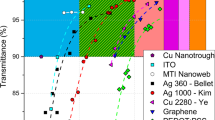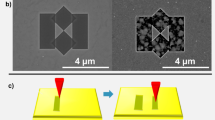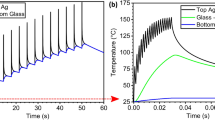Abstract
Nanoscience provides many strategies to construct high-performance materials and devices, including solar cells, thermoelectrics, sensors, transistors, and transparent electrodes. Bottom-up fabrication facilitates large-scale chemical synthesis without the need for patterning and etching processes that waste material and create surface defects. However, assembly and contacting procedures still require further development. Here, we demonstrate a light-induced plasmonic nanowelding technique to assemble metallic nanowires into large interconnected networks. The small gaps that form naturally at nanowire junctions enable effective light concentration and heating at the point where the wires need to be joined together. The extreme sensitivity of the heating efficiency on the junction geometry causes the welding process to self-limit when a physical connection between the wires is made. The localized nature of the heating prevents damage to low-thermal-budget substrates such as plastics and polymer solar cells. This work opens new avenues to control light, heat and mass transport at the nanoscale.
This is a preview of subscription content, access via your institution
Access options
Subscribe to this journal
Receive 12 print issues and online access
$259.00 per year
only $21.58 per issue
Buy this article
- Purchase on Springer Link
- Instant access to full article PDF
Prices may be subject to local taxes which are calculated during checkout






Similar content being viewed by others
References
Baffou, G., Quidant, R. & Girard, C. Heat generation in plasmonic nanostructures: Influence of morphology. Appl. Phys. Lett. 94, 153109 (2009).
Schuller, J. A. et al. Plasmonics for extreme light concentration and manipulation. Nature Mater. 9, 193–204 (2010).
Hirsch, L. R. et al. Nanoshell-mediated near-infrared thermal therapy of tumors under magnetic resonance guidance. Proc. Natl Acad. Sci. USA 100, 13549–13554 (2003).
Röntzsch, L., Heinig, K-H., Schuller, J. A. & Brongersma, M. L. Thin film patterning by surface-plasmon-induced thermocapillarity. Appl. Phys. Lett. 90, 044105 (2007).
Govorov, A. O. et al. Gold nanoparticle ensembles as heaters and actuators: melting and collective plasmon resonances. Nano. Res. Lett. 1, 84–90 (2006).
Soares, B., Jonsson, F. & Zheludev, N. All-optical phase-change memory in a single gallium nanoparticle. Phys. Rev. Lett. 98, 153905 (2007).
Cao, L., Barsic, D. N., Guichard, A. R. & Brongersma, M. L. Plasmon-assisted local temperature control to pattern individual semiconductor nanowires and carbon nanotubes. Nano Lett. 7, 3523–3527 (2007).
Boyd, D. A., Adleman, J. R., Goodwin, D. G. & Psaltis, D. Chemical separations by bubble-assisted interphase mass-transfer. Anal. Chem. 80, 2452–2456 (2008).
Stehr, J. et al. Gold nanostoves for microsecond DNA melting analysis. Nano Lett. 8, 619–623 (2008).
Halas, N. J., Lal, S., Chang, W-S., Link, S. & Nordlander, P. Plasmons in strongly coupled metallic nanostructures. Chem. Rev. 111, 3913–3961 (2011).
Kneipp, K. et al. Single molecule detection using surface-enhanced Raman scattering (SERS). Phys. Rev. Lett. 78, 1667–1670 (1997).
Brongersma, M. L., Hartman, J. W. & Atwater, H. A. Electromagnetic energy transfer and switching in nanoparticle chain arrays below the diffraction limit. Phys. Rev. B 62, R16356–R16359 (2000).
Pendry, J. B., Schurig, D. & Smith, D. R. Controlling electromagnetic fields. Science 312, 1780–1782 (2006).
Shalaev, V. M. Optical negative-index metamaterials. Nature Photon. 1, 41–48 (2007).
Klein, M. W., Enkrich, C., Wegener, M. & Linden, S. Second-harmonic generation from magnetic metamaterials. Science 313, 502–504 (2006).
Romero, I., Aizpurua, J., Bryant, G. W. & García de Abajo, F. J. Plasmons in nearly touching metallic nanoparticles: Singular response in the limit of touching dimers. Opt. Express 14, 9988–9999 (2006).
García de Abajo, F. J. Nonlocal effects in the plasmons of strongly interacting nanoparticles, dimers, and waveguides. J. Phys. Chem. C 112, 17983–17987 (2008).
Zuloaga, J., Prodan, E. & Nordlander, P. Quantum description of the plasmon resonances of a nanoparticle dimer. Nano Lett. 9, 887–891 (2009).
Ward, D. R., Hüser, F., Pauly, F., Cuevas, J. C. & Natelson, D. Optical rectification and field enhancement in a plasmonic nanogap. Nature Nanotech. 5, 732–736 (2010).
Gaynor, W., Burkhard, G. F., McGehee, M. D. & Peumans, P. Smooth nanowire/polymer composite transparent electrodes. Adv. Mater. 23, 2905–2910 (2011).
Gaynor, W., Lee, J-Y. & Peumans, P. Fully solution-processed inverted polymer solar cells with laminated nanowire electrodes. ACS Nano 4, 30–34 (2010).
Hecht, D. S., Hu, L. & Irvin, G. Emerging transparent electrodes based on thin films of carbon nanotubes, graphene, and metallic nanostructures. Adv. Mater. 23, 1482–1513 (2011).
Kang, M-G., Xu, T., Park, H. J., Luo, X. & Guo, L. J. Efficiency enhancement of organic solar cells using transparent plasmonic Ag nanowire electrodes. Adv. Mater. 22, 4378–4383 (2010).
Lee, J-Y., Connor, S. T., Cui, Y. & Peumans, P. Semitransparent organic photovoltaic cells with laminated top electrode. Nano Lett. 10, 1276–1279 (2010).
Li, L. et al. Efficient flexible phosphorescent polymer light-emitting diodes based on silver nanowire–polymer composite electrode. Adv. Mater. 23, 5563–5567 (2011).
Madaria, A. R., Kumar, A. & Zhou, C. Large scale, highly conductive and patterned transparent films of silver nanowires on arbitrary substrates and their application in touch screens. Nanotechnology 22, 245201 (2011).
Yang, L. et al. Solution-processed flexible polymer solar cells with silver nanowire electrodes. ACS Appl. Mater. Interf. 3, 4075–4084 (2011).
Yu, Z., Li, L., Zhang, Q., Hu, W. & Pei, Q. Silver nanowire–polymer composite electrodes for efficient polymer solar cells. Adv. Mater. 23, 4453–4457 (2011).
Yu, Z. et al. Highly flexible silver nanowire electrodes for shape-memory polymer light-emitting diodes. Adv. Mater. 23, 664–668 (2011).
Hu, L., Kim, H. S., Lee, J-Y., Peumans, P. & Cui, Y. Scalable coating and properties of transparent, flexible, silver nanowire electrodes. ACS Nano 4, 2955–2963 (2010).
Karim, S. et al. Morphological evolution of Au nanowires controlled by Rayleigh instability. Nanotechnology 17, 5954–5959 (2006).
Chen, H. et al. Transmission-electron-microscopy study on fivefold twinned silver nanorods. J. Phys. Chem. B 108, 12038–12043 (2004).
Thompson, C. V. Grain growth in thin films. Annu. Rev. Mater. Sci. 20, 245–268 (1990).
Lu, Y., Huang, J. Y., Wang, C., Sun, S. & Lou, J. Cold welding of ultrathin gold nanowires. Nature Nanotech. 5, 218–224 (2010).
Guo, S. The creation of nanojunctions. Nanoscale 2, 2521–2529 (2010).
Cui, Q., Gao, F., Mukherjee, S. & Gu, Z. Joining and interconnect formation of nanowires and carbon nanotubes for nanoelectronics and nanosystems. Small 5, 1246–1257 (2009).
Kim, S. J. & Jang, D-J. Laser-induced nanowelding of gold nanoparticles. Appl. Phys. Lett. 86, 033112 (2005).
Mafuné, F., Kohno, J-Y., Takeda, Y. & Kondow, T. Nanoscale soldering of metal nanoparticles for construction of higher-order structures. J. Am. Chem. Soc. 125, 1686–1687 (2003).
Xu, S. et al. Nanometer-scale modification and welding of silicon and metallic nanowires with a high-intensity electron beam. Small 1, 1221–1229 (2005).
Shin, H. et al. Photoresist-free lithographic patterning of solution-processed nanostructured metal thin films. Adv. Mater. 20, 3457–3461 (2008).
Zhang, Y. et al. Tailoring the intrinsic metallic states of double-walled nanotube films by self-soldered laser welding. Appl. Phys. Lett. 91, 233109 (2007).
Gu, Z., Ye, H., Bernfeld, A., Livi, K. J. T. & Gracias, D. H. Three-dimensional electrically interconnected nanowire networks formed by diffusion bonding. Langmuir 23, 979–982 (2007).
Sommer, J. & Herzig, C. Direct determination of grain-boundary and dislocation self-diffusion coefficients in silver from experiments in type-C kinetics. J. Appl. Phys. 72, 2758–2766 (1992).
Prokes, S. M., Alexson, D., Glembocki, O. J., Park, H. D. & Rendell, R. W. Plasmonic behavior of Ag/dielectric nanowires and the effect of geometry. J. Vacuum Sci. Technol. B 27, 2055–2061 (2009).
Holland, W. & Hall, D. Frequency shifts of an electric-dipole resonance near a conducting surface. Phys. Rev. Lett. 52, 1041–1044 (1984).
Hu, M., Ghoshal, A., Marquez, M. & Kik, P. G. Single particle spectroscopy study of metal-film-induced tuning of silver nanoparticle plasmon resonances. J. Phys. Chem. C 114, 7509–7514 (2010).
Mock, J. J. et al. Distance-dependent plasmon resonant coupling between a gold nanoparticle and gold film. Nano Lett. 8, 2245–2252 (2008).
Chu, Y. & Crozier, K. B. Experimental study of the interaction between localized and propagating surface plasmons. Opt. Lett. 34, 244–246 (2009).
Knight, M. W. et al. Nanoparticle-mediated coupling of light into a nanowire. Nano Lett. 7, 2346–2350 (2007).
Hao, F. & Nordlander, P. Plasmonic coupling between a metallic nanosphere and a thin metallic wire. Appl. Phys. Lett. 89, 103101 (2006).
Wei, H. et al. Polarization dependence of surface-enhanced Raman scattering in gold nanoparticle–nanowire systems. Nano Lett. 8, 2497–2502 (2008).
Le, F. et al. Plasmons in the metallic nanoparticle–film system as a tunable impurity problem. Nano Lett. 5, 2009–2013 (2005).
Cao, L., Fan, P., Barnard, E. S., Brown, A. M. & Brongersma, M. L. Tuning the color of silicon nanostructures. Nano Lett. 2649–2654 (2010).
Du, C. et al. Confocal white light reflection imaging for characterization of metal nanostructures. Opt. Commun. 281, 5360–5363 (2008).
Lee, J-Y., Connor, S. T., Cui, Y. & Peumans, P. Solution-processed metal nanowire mesh transparent electrodes. Nano Lett. 8, 689–692 (2008).
Acknowledgements
This publication was based on work supported by the Center for Advanced Molecular Photovoltaics (CAMP) (Award No KUS-C1-015-21), funded by King Abdullah University of Science and Technology (KAUST). Y.C. acknowledges support from KAUST Investigator Award (No. KUS-I1-001-12). We gratefully acknowledge valuable discussions with P. Nordlander on the optical coupling of metallic nanostructures. E.C.G. acknowledges partial support from the Global Climate and Energy Project at Stanford University.
Author information
Authors and Affiliations
Contributions
E.C.G. and M.L.B. conceived of the experiments, W.C. performed the FEM simulations, J.J.C. performed the TEM, S.T.C. synthesized the silver nanowires, F.M. assisted with the dark-field scattering measurements, M.G.C. built the spray-coating set-up and deposited the silver nanowires on the polymer solar cells and Saran wrap, and E.C.G. performed all other experiments. M.L.B., Y.C. and M.D.M. supervised the project. E.C.G. and M.L.B. wrote the manuscript. All authors discussed the results and contributed to the final version of the manuscript.
Corresponding author
Ethics declarations
Competing interests
The authors declare no competing financial interests.
Supplementary information
Supplementary Information
Supplementary Information (PDF 718 kb)
Rights and permissions
About this article
Cite this article
Garnett, E., Cai, W., Cha, J. et al. Self-limited plasmonic welding of silver nanowire junctions. Nature Mater 11, 241–249 (2012). https://doi.org/10.1038/nmat3238
Received:
Accepted:
Published:
Issue Date:
DOI: https://doi.org/10.1038/nmat3238
This article is cited by
-
Tri-system integration in metal-oxide nanocomposites via in-situ solution-processed method for ultrathin flexible transparent electrodes
Nature Communications (2024)
-
Sandwich structure silver nanowires transparent conductive films with improved photoelectronic performance
Journal of Materials Science (2024)
-
Intense Pulsed Light Welding Process with Mechanical Roll-Pressing for Highly Conductive Silver Nanowire Transparent Electrode
International Journal of Precision Engineering and Manufacturing-Green Technology (2024)
-
High-performance flexible smart window based on copper nanowire/multi-walled carbon nanotube transparent conducting film
Journal of Materials Science (2023)
-
Soft Electronics for Health Monitoring Assisted by Machine Learning
Nano-Micro Letters (2023)



